Why is the Shema an important part of Jewish tradition? How can we use tefilah (prayer) to connect to our holiness? This week, we reviewed the Shema, discussed why it is an important part of Jewish tradition, and reflected on the various holy objects and rituals in our lives.
Last week, the Garinim (kindergartners) approached this question with a deep dive into the Shema, arguably the central text of a Jewish prayer service. We practiced using our breath to connect the words of the Shema to our relationships with God through feelings of love. We watched a video that suggested rather than considering our belief in God, we could instead consider what helps us feel loved, loving, and connected to the world around us. We wondered what it feels like to be loved by different people in our lives, and how we can imagine God giving us that type of love. One of our students was deep in thought as he considered the protective love that his mom gives him coming through God too.
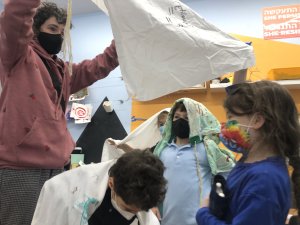

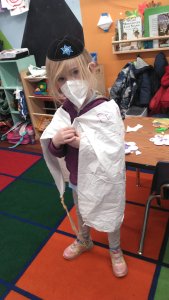
The Garinim explored different frameworks for the Shema at various shulchanot avodah (project centers). At one, we imagined the Shema as a motto or intention to set the tone for a day. We used that idea to design our own mezuzot to house our motto or intention of our creation that we could use to frame our afternoons at Makom Community. At another shulchan, we looked at the Shema as an affirmation of God’s love and created loving affirmations for ourselves. Gaby and Chaim created a big list of the amazing things about our students and put them on petals for kiddos to choose, cut out, color, and add to their own affirmation flower. We hoped that students could take these home and hang them up on their bathroom mirror to be reminded of these incredible things about themselves!
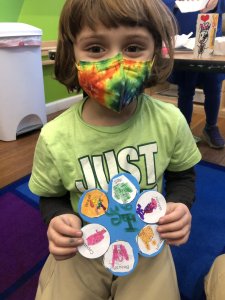
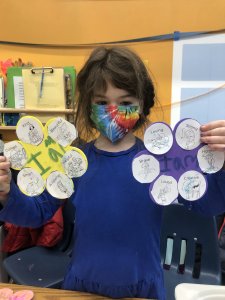
Wednesday ended up being a bit of a funny afternoon. Before we even started with our lesson plan, each kiddo decided to grab a cushion, a pillow, and a blanket from the pinat shalom (peace corner) to make a cozy nest for themselves on the floor. As we worked through our opening activity, kiddos started grabbing tushions and chairs to add to their nest. Apparently what we needed was an afternoon of fort building. That started out well enough, but soon kiddos were arguing over who got to use which parts of the fort, pillows were being thrown in the air, and there was far too much shouting.
We called a pause on the fort building and sat on the carpet together to recalibrate. Kiddos suggested ways to make the process go more smoothly. What can we do if someone else is using a piece of fort equipment that we really want to use?
- Find a different piece to use.
- Go to a different part of the fort.
- Ask if we can use that piece.
- If they say no, it’s OK to be upset, but you have to move on and find something else.
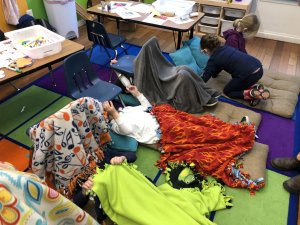
After that conversation, there was a noticeable uptick in how well the Garinim worked together and how much they helped each other with the fort. One student offered to build a room of the fort for another when previously these two had argued over which of them could use that very same space. They asked for quiet and listened to each other. They shared space and materials with polite questions. They were proud of what they accomplished together. We work really hard to create thoughtful lesson plans for these kiddos, and sometimes the most important lessons come from impromptu fort building on cold January afternoons.
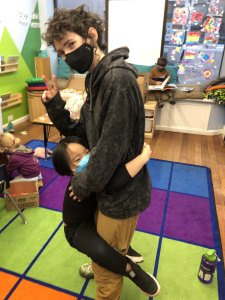
The Shorashim (1st and 2nd graders) had some awesome pieces of wisdom to share with the class in regards to the shema. We delved deeper into the text and kept asking why. Why? Should we say the shema to our children? Why should we recite the shema so many times a day? Why should we inscribe them on our doorposts? Why not inscribe them on a door, or the ground or ceiling? Shorashim said that the shema is so important because it says God is one.
Shorashim watched the video that Garinim watched and we reflected on the question: Is our relationship with God the same as with a classmate or family member?
Kids had many thoughts about this:
- We love God because God is part of our families
- God isn’t real so there’s no connection between them
- We are supposed to love everything in nature and they are equal to God
- My family is more important than God
An activity that kids enjoyed were Shema V’ahavta Charades. Teachers split the group in half and were each given a piece of paper with a bit of text from the Shema and V’ahavta. They worked with their group to figure out how to act out or mime the text and the other team had to guess which part of the text the group was acting out. We then sang the whole thing in Hebrew and English and kids acted out their parts to it.
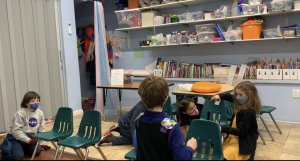
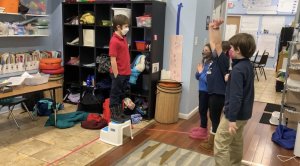
On Thursday, we practiced giving ourselves praise and whether it felt better to say it in our heads or out loud. Each kid thought about their praise in their head and then formed a snap circle to hear everyone share.
Some praises were:
- I’m really good at connect four
- I like school and I’m a good student
- I’m a good friend
- I care about the environment
- I care about animals
Kids had mixed emotions about whether it felt better to say praise aloud or in their head.
Aloud:
- Everyone can hear it
- Feels good for everyone to know
In head:
- No one can judge you
- Speaking to a group of people can be scary
- You aren’t ready to share yet
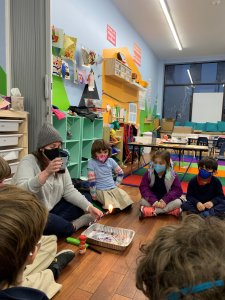
This week’s shulchanot avodah included:
- Motto Making: Kiddos created a motto (a reminder about how to treat others and yourself) and wrote it on colorful paper.
- Everyone will always love you
- Always be good
- Kindness will prevail
- Don’t worry you can make it
- There will always be cuddles in your heart
- The world won’t end
- Love and Kindness
- Believe in yourself
- Motto Symbols: Kids created a symbol that represented their motto on a small tile to keep with them.

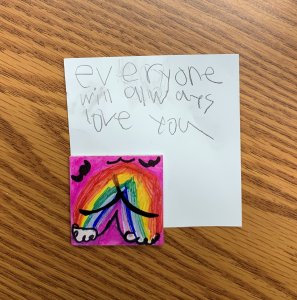
- Shema Crossword
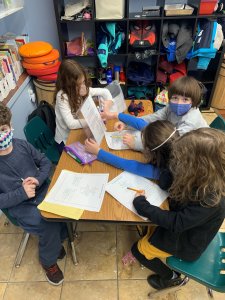
- Book Scavenger Hunt: Kiddos chose from an array of picture books to spot to spot Jewish objects or concepts. Some examples we gave were:
- Siddur (prayer book)
- Kippah (head covering)
- Shofar
- Challah
- Love
- Trees
- God
- Synagogue
- Torah
- Hebrew Letters
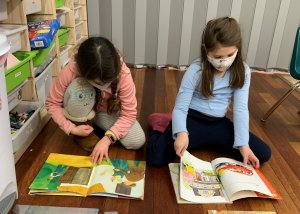
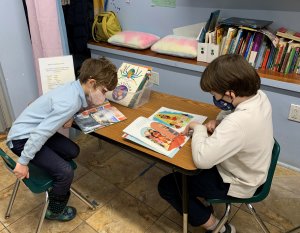
This week Nitzanim (3rd, 4th, and 5th graders) explored the Shema and V’ahavta, imagining the ways the words of the prayers play a part in our lives as individuals and as a community. We started off the week writing affirmations for each other to read aloud, relating the idea of affirmations to the shema. Here were some Nitzanim affirmations:
- You got this!
- I hope you are happy
- Just ignore them
- Today is my day to shine!
- I can do this
Kiddos had some awesome ideas when we reflected on how affirmations made them feel! We found that affirmations can be fuel for our day and make us feel powerful. Reflecting on the Shema and V’ahavta, we found that reciting these prayers can affirm our connection to the greater Jewish community and our culture!
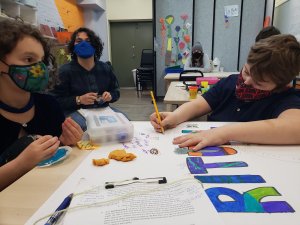
As we continued discussing these prayers, Nitzanim created a web of connection by tossing a ball of yarn to each other in a circle! We then cut the string and created bracelets to remind us that “video games are awesome.” This was a silly example of using something physical to remind us of things, to connect to the instructions which are given in the V’ahavta: using objects to remind us of the words of the Shema. Frankly our kiddos don’t need the string to remember just how awesome video games are.
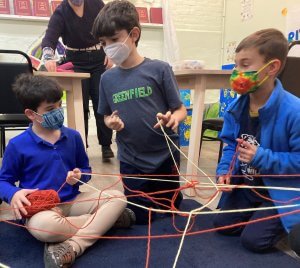
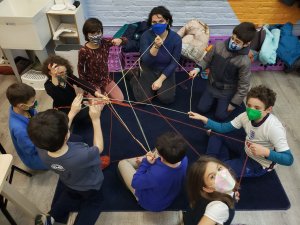
On Wednesday we investigated the commanding nature of the prayers to guide our discussion about how Jewish tradition encourages us to question and even argue with God. We split up and kiddos created an argument for a debate. Each team did a great job structuring and delivering their points.
Nitzanim is getting closer and closer to finishing their sculpey creations and seder plates! They have been bringing their ideas to life in the most amazing and colorful ways. You can’t miss it!
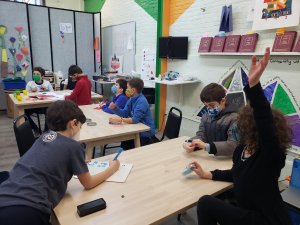
Next week, we will further explore tallit and tzitzit, reflect on the physical reminders they use everyday to make good choices, and how the clothes they wear can make them feel powerful and most like themselves.
